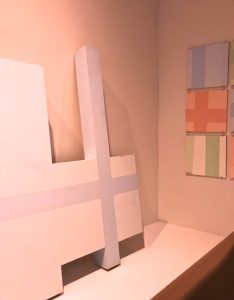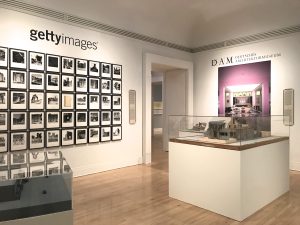November 6, 2018-April 7, 2019
Canadian Centre for Architecture, Montreal
Sylvia Lavin, curator

Architecture Itself and Other Postmodernist Myths, on display at the Canadian Centre for Architecture (CCA) until April 7, 2019, explores architectural autonomy. Postmodernist architecture initially defined itself in opposition to the asemantic formalism of a modern movement absorbed by the pursuit of social utopias and technological development. Architects used historical references, regionalism, typo-morphology, and urban contextualization to counter this absence of meaning. Their epistemological and theoretical exploration gave rise to a concept of architecture as a vehicle for cultural expression, produced independently of the heteronomous conditions that govern it: architecture itself.1

Figure 1a. “Architecture Itself,” installation view of the gallery, Architecture Itself and Other Postmodernist Myths, CCA, 2018. (Photo by Alessandra Mariani.)

Figure 1b. “Architecture Itself,” installation view of the gallery, Architecture Itself and Other Postmodernist Myths, CCA, 2018. (Photo by Alessandra Mariani.)
Curator Sylvia Lavin, professor of architecture at Princeton University, seeks to dismantle such myths about postmodernism through a counternarrative that looks behind the approaches, practices, conditions, and discourses that have sanctioned their existence. In her curatorial statement, Lavin declares that postmodern architects adopted “one version or another of the idea of architecture itself to manage encounters between things operating beyond individual control.”2 The exhibition successfully manipulates this instability within American architecture, revealing how drawings, models, films, and other artifacts have constructed the concept of autonomy and sustained its prevailing myths.
The first thematic grouping, named “Architecture Itself,” tackles the issue head on. Lavin revives a postmodern exhibition that temporarily transformed the CCA galleries into autonomous architecture, by displaying fragments from a 1994 CCA show, Cities of Artificial Excavation: The Work of Peter Eisenman 1978–1988. That exhibition revealed how Eisenman affirmed his conceptual practice through “cardboard architecture,” embodying both his ideation and his formal exploration and development of sites in a perishable material. Lavin’s installation, evoking the scenography used for archaeological remnants, emphasizes the paradoxical destiny of this ephemeral architecture, here transformed into an enduring material artifact by museum conservation. Nearby, a capriccio in brown ink and wash by Giovanni Battista Piranesi (1747–1780) reminds us that the conceptual and immaterial nature of architecture has historically enabled its emergence and its definition.

Figure 2a. “Institutions and their Image,” installation view of the gallery, Architecture Itself and Other Postmodernist Myths, CCA, 2018. (Photo by Alessandra Mariani.)

Figure 2b. “Institutions and their Image,” installation view of the gallery, Architecture Itself and Other Postmodernist Myths, CCA, 2018. (Photo by Alessandra Mariani.)
Six other thematic groupings demonstrate how postmodernism was as diverse and pluralistic as the theoretical and aesthetic concerns that brought it to life. “Institutions and Their Image” focuses on the institutions that have endorsed the development of postmodernist architecture as art and cultural production by constructing and governing its social relations. “Signs and Signals” underscores the vagaries of the architectural narrative generated by another myth contributing to the autonomist stance, namely, architecture conceptualized from grammatical abstraction and semiotics. “Little Things of Knowledge” explores how the intellectual production of academic researchers removed them from the vicissitudes of architectural practice and sustained the myth of autonomy. “Added Value” focuses on how architecture contributed to the establishment of a creative economy, supporting the commercialization of creations that are sometimes difficult to monetize. “Picture Planes” looks at how conceptual drawings produced free from the constraints of the architectural commission are converted into a project’s process and logistics surface, definitively robing its claim to autonomy. Finally, “Bodies Return” addresses the critical issues brought to the fore by race and gender bias and anthropomorphizing architecture.

Figure 3. “Signs and Signals,” installation view of the gallery, Architecture Itself and Other Postmodernist Myths, CCA, 2018. (Photo by Alessandra Mariani.)

Figure 4. “Signs and Signals,” installation view of the gallery, Architecture Itself and Other Postmodernist Myths, CCA, 2018. (Photo by Sandra Larochelle.)

Figure 5. Robert Venturi and Denise Scott Brown, perspective of Guild House, 1961–1966. (Image © The Architectural Archives, University of Pennsylvania; gift of Robert Venturi and Denise Scott Brown.)
To succeed in reformulating the familiar narratives about postmodernism, the exhibition must prompt, as Reinhardt Koselleck asserted, “a reading of the past that disrupts the horizon of expectation” created by these myths.3 Lavin’s move is to transform banal material remnants and facts into a body of evidence. In the section on institutions, for instance, the idea of architecture as art and cultural production is confronted with the logos of these institutions. The exhibition dismantles the immediate cognitive power of images deliberately embraced by museums, making visible the institutionalization of autonomist discourse.4 The remnants here include a photograph of iconic postmodernist models, originals and copies, held by the Deutsches Architekturmuseum, and a model of James Wines’s BEST showroom, designed for a large retailer that promoted postmodernity through its architectural commissions, and now in MoMA’s collections.
Reinhart koselleck, Futures Past: On the Semantics of Historical Time, trans. Keith Tribe (Cambridge, Mass.: MIT Press, 2004).
The concept of logocentrism privileges the phonic aspect of language at the expense of the graphic aspect of writing. In other words, speech is assumed to be the spontaneous and complete means of expression. Image has been given analogously the same properties. Jacques Derrida based his deconstruction discourse on the critical dismantling of the notion of logocentrism, i.e., the referral and privileging of this metaphysic of presence. See Jacques Derrida, Of Grammatology, trans. Gayatri Chakravorty Spivak (Baltimore & London: Johns Hopkins University Press, 1976).

Figure 6. “Added Value,” installation view of the gallery, Architecture Itself and Other Postmodernist Myths, CCA, 2018. (Photo by Alessandra Mariani.)
It is worthwhile considering Lavin’s intentions in depth. In the past ten years, scholars have investigated postmodernism’s heterogeneity. In Architecture’s Historical Turn: Phenomenology and the Rise of the Postmodern (2010), Jorge Otero-Pailos created a history in which phenomenology is postmodernism’s underlying premise. Emmanuel Petit’s 2013 book Irony; or, the Self-Critical Opacity of Postmodern Architecture, suggested that postmodernist architecture is best theorized as irony in the form of interdisciplinary auto-criticism. In Utopia’s Ghost Architecture and Postmodernism Again (2010), Reinhold Martin revived the notion of utopia by merging postmodernism’s major themes into perspectives that consider political, social, and economic issues. Lavin’s neo-Marxist approach confronts the leverage of socioeconomic development to architecture’s creative processes in order “to turn postmodernism from an object of theoretical projection into an empirical object of historical description.” While doing so, the exhibition brings to light the disconnect between the processes involved in creating postmodern architecture and its consciously constructed reception.5 It also sets out the constitutive nature of architecture where heteronomy (economic fluctuations, social context) and autonomy are in perpetual conflict, and demonstrates that the homologation of architectural autonomy derives from facts that do not constitute in themselves “an original founding act,” but rather “an idea to be realized.”6
Manfredo Tafuri argued the historian’s mission was to unveil architecture’s ideology. See Manfredo Tafuri, Theories and History of Architecture, trans. Giorgio Varrechia ( New York: Granada, 1980).
Jean-François Lyotard, The Postmodern Explained: Correspondence 1982–1985, (Minneapolis: University of Minnesota Press, 1992), 18.
Deconstructing postmodern architecture in an exhibition by revealing its flip side, unavowed aspects, and antilogies is a courageous act. Architecture Itself is the product of a research where the tropes of postmodernism (complexity and contradiction, ornament and multiple articulation, collage and juxtaposition, layering and ambiguity, multivalence and double coding, irony) have contributed to identify cases in point and develop its themes. The conceptualization and expansion granted to the findings are reflected in the spatial arrangement of the exhibition, which delivers a convincing counternarrative. If its abundance of writings facilitates the layperson’s acquaintance with the contents, the initiated find pleasure in the reminiscences provoked by these stories within a story, or in the potentialities (the visual methodology opposing image/writing, the furthering of additional themes) of Lavin’s critical stance laid out.
How to Cite this Article: Mariani, Alessandra. Review of Architecture Itself and Other Postmodernist Myths, curated by Sylvia Lavin. Canadian Centre for Architecture, Montreal, QC, November 6, 2018 – April 7, 2019. JAE Online. February 21, 2019. http://www.jaeonline.org/articles/reviews-exhibits/architecture-itself-and-other-postmodernist-myths#/.






